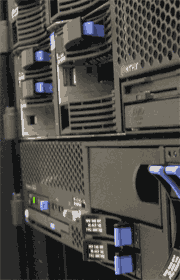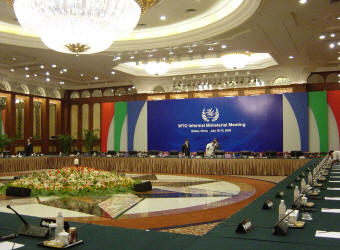Computer Aided Facility Management (CAFM) is the support of facilities management by information technology. The supply of information about the facilities is the center of attention. The tools of the CAFM are called CAFM software, CAFM applications or CAFM systems. CAFM
Facility management is a profession that encompasses multiple disciplines to ensure functionality of the built environment by integrating people, place, process and technology more
To offset some of the costs of installation, building owners and management
professionals
should consider whether or not the integrated system has the flexibility to use
existing
standard computer processors and operating systems. Some other considerations in
evaluating which system best suits a specific application are: System
scalability and expandability, Availability of standard user interfaces, System
architecture based on open standards, Standard networks, cabling and media. Use
of a standard protocol. BOMA (pdf)
Computer Aided Facility Management SoftwareDefinition: CAFM Software is any application that assists management in the coordinating of the workplace with the people and work of the organisation. It includes management of the buildings and services and is sometimes used to mean property management.
The management of large facilities is a complex undertaking in which software is ideally designed to assist. It can help first of all in making a comprehensive inventory of all of a company’s assets located within a given area, whether it be the buildings themselves, important pieces of equipment such as computers or printers, items of furniture and, of course, a register of all company employees who work within the facility. More sophisticated Computer Aided Facility Management suites will contain 3D models of each of the items so that graphical representations of the building space can be created. Some packages may even contained detailed inventory management and ordering facilities, together with barcode reading capabilities, so that even small consumable items such as printer cartridges or packets of envelopes will also be recorded in the software’s database. Computer Aided Facility Management software can help managers in using
building space effectively. The applications often have Computer Aided
Design (CAD) features which permit users to represent the actual internal
layout of the facility within the computer. Rooms, cubicles, computers,
and all relevant items and objects can be depicted. Using the software, an
administrator can play around with alternative layout possibilities,
experimenting with designs which would make more efficient use of the
space available, for example by fitting an extra cubicle or two into an
office room. Many Computer Aided Facility Management packages also
include facilities for plotting and monitoring the less obvious parts of a
building’s infrastructure such as water pipelines, electricity wires and
telephone and computer network cabling. Cost-tracking is an important part of any facility management software. The application should allow an administrator to keep track of all resources, and the costs associated with them, which have been allocated to particular elements within the facility over a period of time. In this way, for example, an administrator should be able to see at a glance how much the decades-old generator in building 1 costs to maintain in one year compared to the brand spanking new generator in building 2. Although Computer Aided Facility Management Software itself can be expensive, the software vendors argue that it quickly pays for itself by allowing facility operators to spot instances of resource under-utilisation and therefore to exploit their own assets more fully, ultimately lowering the company’s operating costs.
Security facilities are included in some of the more sophisticated Computer Aided Facility Management packages. These allow an administrator to set the security clearance levels required to access different parts of a building complex, and to allocate clearance levels to all personnel registered within the software’s database. Some packages may permit integration with real-world security protection mechanisms such as security doors and access cards. If the facility has CCTV cameras, their images can be routed to a control room where they can be monitored by security staff. Data from intruder and fire alarm systems can also be fed into the software so that the location where an alarm has been triggered will be immediately apparent. In most countries there is a large body of health and safety-related regulation which building managers must comply with in order to remain within the law. Some Computer Aided Facility Management software is designed to help in this regard. Relevant laws and regulations for a variety of countries will have been pre-programmed into the software as it shipped and there will usually be some form of online update facility to take account of any significant changes which may occur within the legislative landscape. When a proposed action touches on a compliance issue, the software will flag the matter for a manager’s attention. In addition, the Computer Aided Facility Management package will allow a comprehensive record of all health and safety related issues to be kept down to the level of individual pieces of equipment. If outside personnel are required to visit the facility for any reason, for example to perform maintenance on a certain piece of equipment, the software can include relevant safety instructions for that part of the complex along with the work order. Although most elements of Computer Aided Facility Management Software packages are designed for use by administrators, in some cases parts of their functionality may be made available to ordinary staff members. For example, some Computer Aided Facility Management applications incorporate resource booking functionality, allowing users to book rooms or conference suites through the software. |

 Much
Computer Aided Facility Management Software is generic in nature, readily
adaptable to premises managed by any large organisation. More specialised
applications do exist too, however, usually offered as add-ons to the
generic software. Some examples of these niche Computer Aided Facility
Management applications include those designed to deal with asbestos
issues, or those equipped with special features for handling property
rental.
Much
Computer Aided Facility Management Software is generic in nature, readily
adaptable to premises managed by any large organisation. More specialised
applications do exist too, however, usually offered as add-ons to the
generic software. Some examples of these niche Computer Aided Facility
Management applications include those designed to deal with asbestos
issues, or those equipped with special features for handling property
rental.  A
Computer Aided Facility Management package can also act as a central
control point for receipt of fault reports and repair requests for either
parts of the facility or items within it. It can keep a record of these
and how they were dealt with, allowing reports to be generated showing
statistically which items or elements within the building give rise to the
most problems and what the costs of dealing with those problems were. Over
significant time periods, this permits facility managers to gain greater
insight into the total cost of ownership (TCO) of the assets under their
control.
A
Computer Aided Facility Management package can also act as a central
control point for receipt of fault reports and repair requests for either
parts of the facility or items within it. It can keep a record of these
and how they were dealt with, allowing reports to be generated showing
statistically which items or elements within the building give rise to the
most problems and what the costs of dealing with those problems were. Over
significant time periods, this permits facility managers to gain greater
insight into the total cost of ownership (TCO) of the assets under their
control.